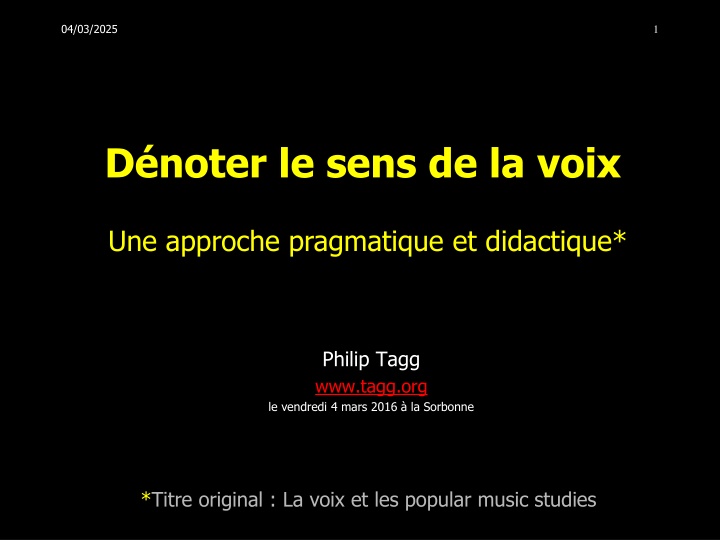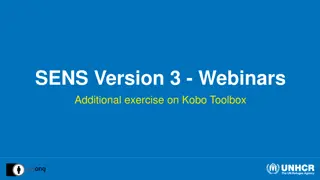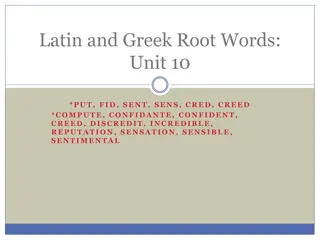Dénoter le sens de la voix
Approaching the non-verbal sense of voice in music studies, delving into vocal sounds poetically, acoustically, and aesthetically. Addressing fundamental issues in music analysis, such as ethnocentrism and terminology, through practical solutions.
Download Presentation

Please find below an Image/Link to download the presentation.
The content on the website is provided AS IS for your information and personal use only. It may not be sold, licensed, or shared on other websites without obtaining consent from the author.If you encounter any issues during the download, it is possible that the publisher has removed the file from their server.
You are allowed to download the files provided on this website for personal or commercial use, subject to the condition that they are used lawfully. All files are the property of their respective owners.
The content on the website is provided AS IS for your information and personal use only. It may not be sold, licensed, or shared on other websites without obtaining consent from the author.
E N D
Presentation Transcript
04/03/2025 1 D noter le sens de la voix Une approche pragmatique et didactique* Philip Tagg www.tagg.org le vendredi 4 mars 2016 la Sorbonne *Titre original : La voix et les popular music studies
Survol D noter le sens non-verbal : probl me fondamental de toute analyse musicale D crire quoi? 79 personnages vocaux [17:33] Comment d noter les sons vocaux : aspects po tique, acoustique, eth sique Comment concr tiser le sens du vocal : imitation / appropriation (impersonation) 2 04/03/2025
Deux problmes fondamentaux The Popular Music Studies establishment Everything except the music The euroclassical/jazz establishment Nothing but the music Problems of ethnocentrism and terminology Four constructive solutions [1] demystify music, [2] terminology reform, [3] aesthesic descriptors (incl. vox), [4] inclusion and integration of music (NIMiMS & semiotics) 3
The Popular Music Studies Establishment The Fame conservatoire Preparing for the industry ? What industry? Different from the euroclassical or jazz conservatoire? Or just more performing seals ? Nothing but the music? The cult-stud institution Once trendy (1980s-1990s) canons of theory Semiotics is out of date (sic!). He has no knowledge of popular music studies. Everything but the music: a troublesome appendage to cultural studies (Fabbri, 1995) 4 04/03/2025
Deux problmes fondamentaux The Popular Music Studies establishment Everything except the music The euroclassical/jazz establishment Nothing but the music Problems of ethnocentrism and terminology Four constructive solutions [1] demystify music, [2] terminology reform, [3] aesthesic descriptors (incl. vox), [4] inclusion and integration of music (NIMiMS & semiotics) 5
Euroclassical establishment 1. Ethnocentric 2. Class-centric 3. Culturally absolutist 4. Aesthetically absolutist Next: a few symptoms of 1-4 P Tagg IbAm08
Euroclassical establishment. Basic problem 1: scribal/oral, notation/recording 1. Hegemony of number and written word in academe, of the scribal, of the scopocentric (=fixated on vision) and relative neglect of non-verbal sound (oral/aural). 2. Tendency to privilege parameters of musical expression storable in Western staff notation, developed to encode complexities intrinsic to various forms of Western art music, not those of other music cultures (timbre, micro- inflexion, cross-rhythm, etc.). P Tagg HK 0303
Euroclassical establishment, basic problem 2: hijacking of music Visited 2012-05-03 8 04/03/2025
2 problmes fondamentaux 1. The Popular Music Studies establishment Everything except the music 2.The euroclassical/jazz establishment Nothing but the music Problems of ethnocentrism and terminology Four constructive solutions [1] demystify music, [2] terminology reform, [3] aesthesic descriptors (incl. vox), [4] inclusion and integration of music (NIMiMS & semiotics) 9
1. Demystification Chapters 1-4 demystify notions of music (incl. bio-acoustic universals , music & the brain, emotion, mood, music is music (1 & 2), ethno-, socio- and semio- approaches http://tagg.org/mmmsp/NonMusoInfo.htm 04/03/2025 10
2. Tonal terminology: examples of reform Chapters 3-4 on modes (incl. penta-, hexa- & heptatonic; Hijaz, maqams, lydian 7, blues pentatonicism, doh- r - la- pentatonics, coherent theory of tonical hexatonic modes, etc., not just the usual 7!) EvTon2MMMSP.jpg Chapters 8-9: tertial harmony ([euro]classical, non-classical; difference triad/third, etc.) Chapter 10: quartal harmony (no sus !, shorthand, tonical neighbourhood, 11 chords, quartal classical, quartal jazz, quartal rock, news jingles, folk 4ths and 5ths, etc.) http://tagg.org/mmmsp/EverydayTonalityInfo.htm 11 04/03/2025
3. Dscripteurs ethsiques tr s bient t 4. Inclusion and integration of music as sonic materiality in studies of music and culture See http://nimims.net 04/03/2025 12
Survol D noter le sens non-verbal : probl me fondamental de toute analyse musicale D crire quoi? 79 extraits de personage vocal [17:33] Comment d noter les sons vocaux : aspects po tique, acoustique, eth sique Comment concr tiser le sens du vocal : imitation / appropriation (impersonation) 13 04/03/2025
Play montage http://tagg.org/Clips/AVmat/ParisVoxAll.mp4 [17:33] then check Excel file http://tagg.org/teaching/analys/ParisVocExx.xlsx 04/03/2025 14
Survol D noter le sens non-verbal : probl me fondamental de toute analyse musicale D crire quoi? 79 extraits de personage vocal (17 ') Comment d noter les sons vocaux : aspects po tique, acoustique, eth sique Comment concr tiser le sens du vocal : imitation / appropriation (impersonation) 15 04/03/2025
Vocal costume habits vocaux, costume vocal, tenue vocale cf. swimming costume, actor s costume, military or school uniform, national/regional costume, habits de dimanche/de deuil, costume bretonne, tenue de bain, etc. costume = clothing worn, for practical or conventional reasons, to carry out a particular activity, or to show an identity Spoken costumes (examples) telephone voice (1950s) interactive voice recognition (Claire, Julie, Emily, Taxi 8585) public speaking voice, primary school teacher voice Sung costumes (examples) bel canto, Wagner soprano, heroic tenor, opera buffa bass blues shouter, folk singer, crooner, rock yeller/screamer/belter Bulgarian diaphony, Mongolian throat singing, Inuit katajjaq, cante jondo, Gaelic keening (caoine), etc.
General types of vocal descriptor po etic how sounds are produced: breathing, control, projection, register, posture, nose, head, chest, diaphragm, vocal chords (folds), etc. volume, dynamics, intensity, partials, transients, fundamentals, amplitude, etc. acoustic aesthesic perceived traits: sound descriptors, transmodal metaphors, personas
Catgories ethsiques de dscription vocale (1) 1. Descripteurs sonores (examples) aboyer, acclamer, bavarder, b gayer, b ler, bourdonner, brailler, braire, bredouiller, chantonner, chevrotter, chuchoter, claironner, claquer, cracher, crier, croasser, d clamer, d noncer, d toner, fredonner, gazouiller, glousser, grincer, grommeler, gronder, haleter, hoqueter, huer, hululer, hurler, marmonner, marmotter, miauler, mugir, p pier, pleurer, postillonner, proclamer, psalmodier, r citer, ricaner, rire, ronchoner, roucouler, rousp ter, sangloter, scander, se plaindre, s'exclamer, siffler, soupirer, striduler, tonner, tousser, vrombir, etc. High-pitched, low-pitched, deep, full-throated, gruff, breathy, husky, nasal, gutteral, distinct, indistinct, harsh, muffled, hoarse, shrill, monotone, etc. 2. Transmodal (anaphonic/synaesthetic) descriptors e.g. sweet, smooth, rough, rounded, sharp, angular, velvety, scratchy, piercing, clean, clear, shaky, wobbly, brassy, grainy, gravelly, etc.
VOCAL PERSONA personnage vocal du latin personare = sonner travers (to sound through), comme le son de la voix du personnage projet vers le public travers le masque d'un acteur dans le th tre gr co-romain personnage vehicul par voie vocale, non-lexicale, qui convient souvent une description verbale arch type.
Vocal persona (citations) Face l' coute d'exemples de diff rentes voix, nos auditeurs peuvent d duire le statut socio- conomique, les traits de personnage, ainsi que l' tat motionnel et mental du locuteur. Nos auditeurs sont capables de juger l' ge, la taille et le poids des locuteurs enregistr s avec autant de pr cision que produit l'examination des photos. On est aussi capable, 3 fois sur 4, de correctement identifier la photo correspondant la voix du locuteur. Hughes, Susan M et al. (2004). Ratings of voice attractiveness predict sexual behavior . Evolution and Human Behavior, 25: 295 304
Vocal persona characteristics (quotes) hard-edged sexual exuberance impish chirp Barbie dolls cuddly vocal personality nervous teenage male, fearful of rejection angry smurf Western mythical girl/woman, heartbroken yet resilient and entirely feminine
Aesthesic voice description categories (2) 3. Persona descriptors (a-c: d on next slide) Sean Connery, Clint Eastwood, Morgan Freedman; Billy Holiday, Kate Bush, Bj rk, etc. a) Named persons man, woman, boy, girl, old, young, middle-aged language, dialect, regional/class accent, etc. b) Demographic c) Emotional cute, cuddly, sweet, nice; wise, confident, etc. melancholy, bored, bland, nondescript, neutral willful, determined, brave; bubbly, cheeky, cheery, jaunty, etc. hip, cool, seductive; sardonic, sarcastic, ironic, nasty, evil vulnerable, embarrassed, scared, edgy, nervous, angry, frustrated depressed, sad, alienated, anguished, desperate, suicidal, etc., etc.
Aesthesic voice description categories (3) 3. Persona descriptors (d): professions, roles, archetypes alien, Barbie doll, big boss, bitch, elder, evil child, evil queen, dirty old man, Druid, fat cat, father, football hooligan, gangster, geek, guide, heroine, hero, imp, lager lout, miser, monster, mother, nerd, priest, princess, robot, sissy, soldier, teenager, vamp, villain, wiseguy, witch, etc. combinations of 3a, b and c with some vocal costume elements (next)
Vocal costume (recap) habits vocaux, costume vocal, tenue vocale cf. swimming costume, actor s costume, military or school uniform, national/regional costume, habits de dimanche/de deuil, costume bretonne, tenue de bain, etc. costume = clothing worn, for practical or conventional reasons, to carry out a particular activity, or to show an identity Spoken costumes (examples) telephone voice (1950s) interactive voice recognition (Claire, Julie, Emily, Taxi 8585) public speaking voice, primary school teacher voice Sung costumes (examples) bel canto, Wagner soprano, heroic tenor, opera buffa bass blues shouter, folk singer, crooner, rock yeller/screamer/belter Bulgarian diaphony, Mongolian throat singing, Inuit katajjaq, cante jondo, Gaelic keening (caoine), etc.
Survol D noter le sens non-verbal : probl me fondamental de toute analyse musicale D crire quoi? 79 extraits de personage vocal (17 ') Comment d noter les sons vocaux : aspects po tique, acoustique, eth sique Comment concr tiser le sens du vocal : imitation / appropriation (impersonation) 25 04/03/2025
Vocal persona 4 [1]: ten steps see Music's Meanings, pp. 378-379 1. Isolate vocal passage whose characterstics you want to understand. 2. Play back that passage as a loop. 3. Listening to the loop, impersonate the voice. Do not sing the words at this stage. 4. Keep on impersonating and stop the loop playback. 5. Describe the sound you're making, and how you're producing it (throat, mouth, nose, head, lungs, etc.). 6. Describe body posture and movement best suited to making the vocal sound, incl. eyes, teeth, jaw, chin, face muscles, shoulders, arms, hands; standing or sitting? Posture/movements suggest what attitude/emotion? 26
Vocal persona 4 [2]: ten steps 7. What words best fit the vocal sound you re imitating? Is it any of these? I LOVE YOU. I HATE YOU. LIFE IS POINTLESS. THIS IS FUN. I M BORED. I M A CREEP COME CLOSER! GO AWAY! YOU RE GORGEOUS. YOU RE STUPID. THIS MAKES ME LAUGH. I DESPISE YOU. I M SICK OF IT. I M WORRIED. I WON T GIVE IN. I DON T CARE. THIS IS FANTASTIC. What words sound ridiculous or are impossible to say with the facial expression and body posture you ve adopted to produce your impersonation? 8. Where is this sort of voice most likely to be heard? Bedroom? Church? Bar?.... 27
Vocal persona 4 [3]: ten steps 9. What sort of person (age, gender, nationality, occupation, etc.) might typically be talking in that way? Is it a lover, sister, brother, teacher, preacher, best friend, enemy, trickster, philosopher, or any of those listed in section 3 of the table on slide 22? 10. What words best describe the vocal sound you re impersonating? Is it any of the concepts shown in slides 22-23? 28
FIN Philip Tagg, Paris: 2016-03-04 www.tagg.org 04/03/2025 29








